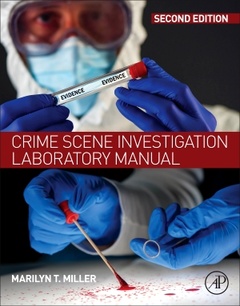Description
Crime Scene Investigation Laboratory Manual (2nd Ed.)
Author: Miller Marilyn T
Language: English
Subject for Crime Scene Investigation Laboratory Manual:
264 p. · 21.5x27.6 cm · Paperback
Description
/li>Contents
/li>Readership
/li>Biography
/li>Comment
/li>
Crime Scene Investigation Laboratory Manual, Second Edition, is written by a former crime scene investigator and forensic scientist who provides practical, straightforward, and immediately applicable best practices. Readers will learn the latest techniques and procedures, including deconstructing first responder contamination, the preliminary walk-through, utilizing associative evidence, enhancing trace, biological and chemical evidence, and reconstructing scenes through wound dynamics, glass fracture patterns, bloodstain patterns, ballistics, and more. This lab manual provides information and examples for all aspects of crime scene investigation.
In addition, included exercises teach the proper techniques for securing, documenting and searing a crime scene, how to visualize or enhance the evidence found, how to package and preserve the evidence, and how to reconstruct what happened at the crime scene. This manual is intended to accompany any crime scene investigation textbook.
SECTION I Exercise A: Defining a Crime Scene Exercise B: Physical Evidence at Crime Scenes Exercise C: Locard Exchange Principle SECTION II Exercise D: First Responders at Crime Scenes Exercise E: Crime Scene Security Exercise F:Preliminary Scene Survey SECTION III Exercise G: Crime Scene Documentation: Notes Exercise H: Crime Scene Documentation: Videography Exercise I: Crime Scene Documentation: Photography Exercise J: Crime Scene Documentation: Sketching SECTION IV Exercise K: Physical Searches Exercise L: Visualization and Enhancement: Lighting Aids Exercise M: Visualization and Enhancement: Biological Evidence Exercise N: Visualization and Enhancement: Chemical Evidence Exercise O: Visualization and Enhancement: Combination Methods Exercise P: Packaging, Preservation, and Collection of Evidence SECTION V Exercise Q: Final Scene Survey Exercise R: Crime Scene Reconstruction: Wound Dynamics Exercise S: Crime Scene Reconstruction: Glass Fracture Patterns Exercise T: Crime Scene Reconstruction: Bloodstain Patterns I Exercise U: Crime Scene Reconstruction: Bloodstain Patterns II Exercise V: Crime Scene Reconstruction: Shooting Investigations Exercise W: Crime Scene Reconstruction: Report Writing and Mock Scene Reconstruction
Primary courses in crime scene investigation, taught in both forensic science and criminal justice programs, and law enforcement training programs
- Designed to complement any text used in crime scene investigation courses
- Contains over 20+ proven exercises and material from actual crime scenes, providing students with hands-on learning
- Written by an experienced educator and former crime scene investigator/forensic scientist




